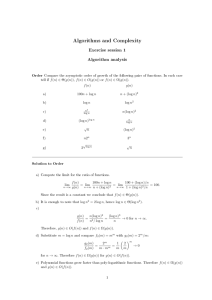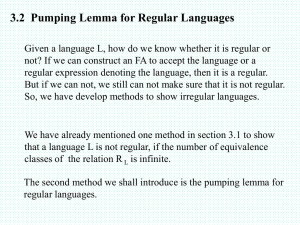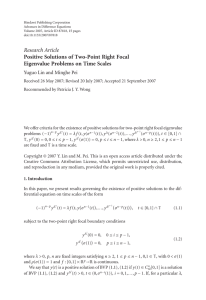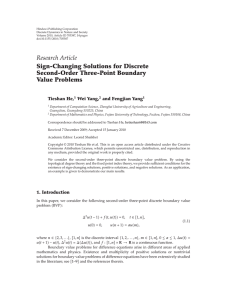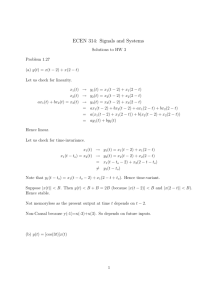Senior Category – Solutions - EMC – European mathematical cup
advertisement
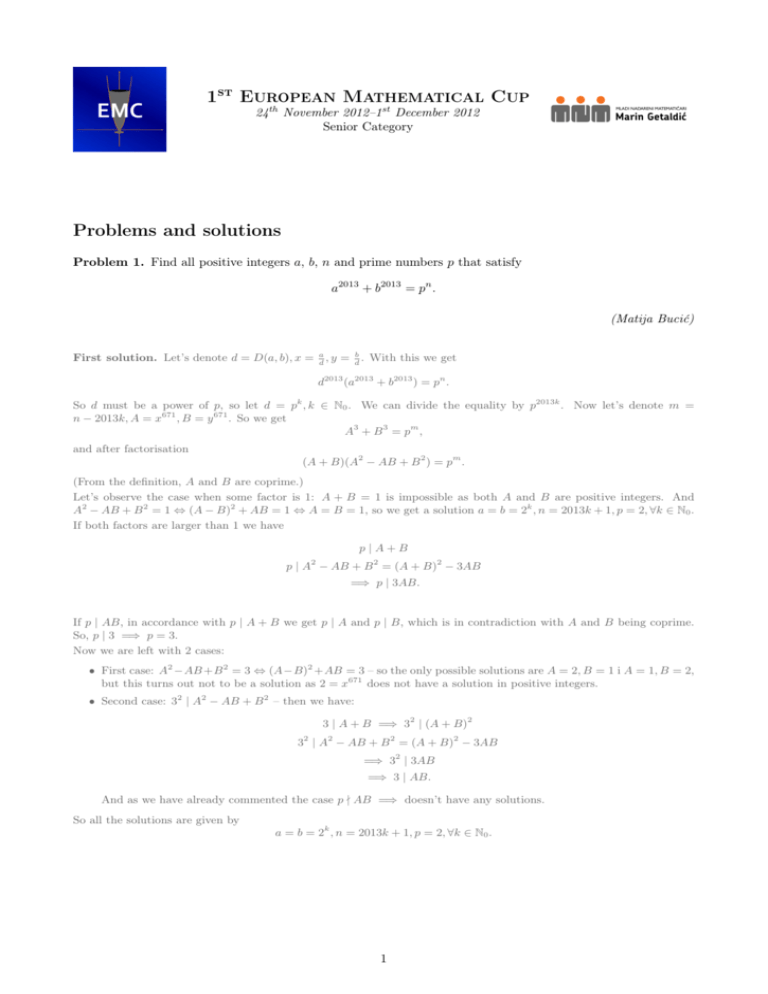
1st European Mathematical Cup
24th November 2012–1st December 2012
Senior Category
MLADI NADARENI MATEMATIČARI
Marin Getaldic
Problems and solutions
Problem 1. Find all positive integers a, b, n and prime numbers p that satisfy
a2013 + b2013 = pn .
(Matija Bucić)
First solution. Let’s denote d = D(a, b), x =
a
,y
d
= db . With this we get
d2013 (a2013 + b2013 ) = pn .
So d must be a power of p, so let d = pk , k ∈ N0 . We can divide the equality by p2013k . Now let’s denote m =
n − 2013k, A = x671 , B = y 671 . So we get
A3 + B 3 = pm ,
and after factorisation
(A + B)(A2 − AB + B 2 ) = pm .
(From the definition, A and B are coprime.)
Let’s observe the case when some factor is 1: A + B = 1 is impossible as both A and B are positive integers. And
A2 − AB + B 2 = 1 ⇔ (A − B)2 + AB = 1 ⇔ A = B = 1, so we get a solution a = b = 2k , n = 2013k + 1, p = 2, ∀k ∈ N0 .
If both factors are larger than 1 we have
p|A+B
2
p | A − AB + B 2 = (A + B)2 − 3AB
=⇒ p | 3AB.
If p | AB, in accordance with p | A + B we get p | A and p | B, which is in contradiction with A and B being coprime.
So, p | 3 =⇒ p = 3.
Now we are left with 2 cases:
• First case: A2 −AB +B 2 = 3 ⇔ (A−B)2 +AB = 3 – so the only possible solutions are A = 2, B = 1 i A = 1, B = 2,
but this turns out not to be a solution as 2 = x671 does not have a solution in positive integers.
• Second case: 32 | A2 − AB + B 2 – then we have:
3 | A + B =⇒ 32 | (A + B)2
32 | A2 − AB + B 2 = (A + B)2 − 3AB
=⇒ 32 | 3AB
=⇒ 3 | AB.
And as we have already commented the case p - AB =⇒ doesn’t have any solutions.
So all the solutions are given by
a = b = 2k , n = 2013k + 1, p = 2, ∀k ∈ N0 .
1
Second solution. As in the first solution, we take the highest common factor of a and b (which must be of the form
pk ). Factorising the given equality we get
(x + y)(x2012 − x2011 y + x2010 y 2 − · · · − xy 2011 + y 2012 ) = pm .
(We’re using the same notation as in the first solution.) Denote the right hand side factor by A. As x and y are natural
numbers, we have x + y > 1 =⇒ p | x + y. So p - x and p - y (as x and y are coprime). Now by applying LTE (Lifting
the Exponent Lemma):
νp (x2013 + y 2013 ) = νp (x + y) + νp (2013)
Now we know νp (2013) = 0 fo all primes p except 3, 11, 61, and in the remaining cases νp (2013) = 1. Note A = 1 and
(x, y) = (1, 1) and A > 61 for (x, y) 6= (1, 1). This inequality holds because for (x, y) 6= (1, 1) (WLOG x > y), we can
write A as
x2011 (x − y) + x2009 y 2 (x − y) + · · · + xy 2010 (x − y) + y 2012 ,
which is greater than 61 in cases x > y and y 6= 1.
• If νp (2013) = 1 =⇒ νp (A) = 1 =⇒ A ∈ {3, 11, 61} which is clearly impossible.
• If νp (2013) = 0 =⇒ νp (A) = 0 =⇒ A = 1 =⇒ (x, y) = (1, 1), so we get a solution
a = b = 2k , n = 2013k + 1, p = 2, ∀k ∈ N0 .
Problem 2. Let ABC be an acute triangle with orthocenter H. Segments AH and CH intersect segments
BC and AB in points A1 and C1 respectively. The segments BH and A1 C1 meet at point D. Let P be the
midpoint of the segment BH. Let D0 be the reflection of the point D in AC. Prove that quadrilateral AP CD0
is cyclic.
(Matko Ljulj)
First solution. We shall prove that D is the orthocenter of triangle AP C. From that the problem statement follows as
∠AD0 C = ∠ADC = 180◦ − ∠DAC − ∠DCA = (90◦ − ∠DAC) + (90◦ − ∠DCA) =
= ∠P CA + ∠P AC = 180◦ − ∠AP C.
We can note that quadrilateral BA1 HC1 is cyclic. Lines BA1 and C1 H intersect in C, lines BC1 and A1 H intersect in
A, lines BH and C1 A1 intersect in D, and point P is the circumcenter of BA1 HC1 . So by the corollary of the Brocard’s
theorem point D is indeed the orthocenter of triangle AP C as desired.
Second solution. Denote by B1 the orthogonal projection of B on AC. By cyclic quadrilaterals B1 C1 P A1 (Euler’s
circle), HA1 CB1 , AC1 A1 C and C1 HB1 A we get the following equations:
∠A1 P B1 = ∠DC1 B1
∠A1 B1 P = ∠A1 CC1 = ∠A1 AC1 = ∠DB1 C1 .
From these equalities we get that triangles B1 P A1 and B1 C1 D are similar, which implies
|B1 D|
|B1 C1 |
=
=⇒ |B1 A1 | · |B1 C1 | = |B1 D| · |B1 P |.
|B1 A1 |
|B1 P |
Analogously, using cyclic quadrilateral ABA1 B1 and C1 BCB1 we get the following angle equations:
∠B1 AC1 = 180◦ − ∠B1 A1 B = ∠B1 A1 C
∠AB1 C1 = 180◦ − ∠C1 B1 C = ∠CBA = 180◦ − ∠A1 B1 A = ∠A1 B1 C.
From these equalities we get that triangles B1 AC1 and B1 AC are similar so
|B1 C1 |
|AB1 |
=
=⇒ |B1 A1 | · |B1 C1 | = |B1 A| · |B1 C|.
|B1 C|
|A1 B1 |
Thus we get |B1 D0 | · |B1 P | = |B1 D| · |B1 P | = |B1 A1 | · |B1 C1 | = |B1 A| · |B1 C| so by the reverse of the power of the point
theorem the quadrilateral AP CD0 is cyclic as desired.
2
Problem 3. Prove that the following inequality holds for all positive real numbers a, b, c, d, e and f :
s
r
p
abc
def
3
+ 3
< 3 (a + b + d)(c + e + f ).
a+b+d
c+e+f
(Dimitar Trenevski)
Solution. The inequality is equivalent to
s
3
abc
+
(a + b + d)2 (c + e + f )
By AM-GM inequality we have
s
3
s
3
abc
1
6
(a + b + d)2 (c + e + f )
3
def
1
6
(a + b + d)(c + e + f )2
3
s
3
def
< 1.
(a + b + d)(c + e + f )2
a
b
c
+
+
a+b+d
a+b+d
c+e+f
d
e
f
+
+
a+b+d
c+e+f
c+e+f
,
.
Adding the inequalities we get
s
s
abc
def
1 a+b+d
c+e+f
2
3
3
+
6
+
= < 1,
(a + b + d)2 (c + e + f )
(a + b + d)(c + e + f )2
3 a+b+d
c+e+f
3
as desired.
Problem 4. Olja writes down n positive integers a1 , a2 , . . . , an smaller than pn where pn denotes the n-th
prime number. Oleg can choose two (not necessarily different) numbers x and y and replace one of them with
their product xy. If there are two equal numbers Oleg wins. Can Oleg guarantee a win?
(Matko Ljulj)
Solution. For n = 1, Oleg won’t be able to write 2 equal numbers on the board as there will be only one number written
on the board. We shall now consider the case n > 2.
Let’s note that as all the numbers are strictly smaller than pn we have all their prime factors are from the set
{p1 , p2 , . . . , pn−1 }, so there are at most n − 1 of them in total. We will represent each number a1 , a2 , . . . , an by the
αi,(n−1)
α
α
ordered (n − 1)-tuple of non-negative integers in the following way if ai = p1 i,1 · p2 i,2 · . . . · pn−1
, then we assign
vi = (αi,1 , αi,2 , . . . , αi,(n−1) ), for all i ∈ {1, 2, . . . , n}.
Let’s consider the following system of equations:
α1,1 x1 + α2,1 x2 + · · · + αn,1 xn = 0
α1,2 x1 + α2,2 x2 + · · · + αn,2 xn = 0
···
α1,(n−1) x1 + α2,(n−1) x2 + · · · + αn,(n−1) xn = 0
There is a trivial solution x1 = x2 = · · · = xn = 0. But as this system has less equalities than variables we can deduce
that it has infinitely many solutions in the set of rational numbers (as all the coefficients are rational). Let (y1 , y2 , . . . , yn )
be a not trivial solution (so the solution in which not all of yi equal 0). Then we can rewrite the initial system using
a1 , a2 , . . . , an :
n
Y
i=1
ayi i =
n
Y
α
p1 i,1
yi
α
· p2 i,2
yi
α
i,(n−1)
· . . . · pn−1
yi
=
i=1
n−1
Y
α
pj 1,j
j=1
=⇒
n
Y
y1 +α2,j y2 +···+αn,j yn
=
n−1
Y
p0j = 1
j=1
ayi i = 1.
i=1
Considering the numbers y1 , y2 , . . . , yn as rational numbers in which the respective nominator and denominator are
coprime, Denote by L the lowest common multiplier of their denominators. Taking the L-th power of the upper equality
we get integer exponents in the upper equation (which don’t have a common factor). Furthermore, WLOG we can
assume that a1 , a2 , . . . , ak are those elements ai whose exponents are negative and numbers ak+1 , ak+2 , . . . , ak+l are
3
those elements with postivie exponent (for some k, l ∈ N, k + l 6 n). Then, when we shift all ai -s with negative exponent
to the opposite side of the equation and when those with zero exponent get ruled out we get that the following equality
k
Y
l
Y
ari i =
i=1
ari i
(1)
i=k+1
holds for some positive integers r1 , r2 , . . . , rk+l for which D(r1 , r2 , . . . , rk+l ) = 1 and for some numbers a1 , a2 , . . . , ak+l .
(We can note that there is at least one number ai on both sides of the equality otherwise we have only ones on the
board.)
We shall prove that there is a sequence of transformations by which using this relation we will get two equal numbers
among a1 , a2 , . . . an .
Lemma 1. Let (a, b) ∈ N2 and (x1 , x2 ) ∈ N2 be such that GCD(x1 , x2 ) = 1. Then there exists a sequence of transformations which replaces the numbers (a, b) with (a0 , b0 ), where one of these numbers a0 , b0 is equal to ax1 bx2 .
Proof. We’ll prove this by induction on x1 + x2 , for all (a, b) ∈ N2 . As the basis consider x1 + x2 = 2 =⇒ x1 = x2 = 1.
The number ab we can get by applying transformation (a, b) → (a, ab).
Let’s assume that the claim holds for all (x1 , x2 ) such that x1 + x2 < n, and for all (a, b). Let’s take some numbers
(x1 , x2 ) such that x1 + x2 = n and some arbitrary numbers (a, b). If x1 = x2 is satisfied, since x1 and x2 are coprime, we
could conclude that both numbers are equal to 1, but we have already proved this case in basis. Let’s assume x1 6= x2 .
WLOG x1 > x2 . Then we apply the transformation (a, b) → (a, ab), and then apply the induction hypothesis on numbers
(a, ab) and (x1 − x2 , x2 ):
(a, b) → (a, ab) → (γ, ax1 −x2 (ab)x2 ) = (γ, ax1 bx2 ),
where γ is some positive integer, what we wanted to prove.
Lemma 2. Let k ∈ N, (b1 , b2 , . . . bk ) ∈ Nk and (x1 , x2 , . . . xk ) ∈ Nk . Then there exists sequence of transformations which
instead of numbers (b1 , b2 , . . . bk ) writes down numbers (b01 , b02 , . . . b0k ) such that one of those numbers is equal to
1
x
(bx1 1 bx2 2 · · · bkk ) d ,
where d denotes greatest common divisor of numbers x1 , x2 , . . . xk .
Proof. Intuitively, this lemma is just Lemma 1 repeated (k − 1) times.
We’ll prove this by induction on k, for all b1 , b2 , . . . bk and x1 , x2 , . . . xk . In the basis, for k = 1, it holds d = x1 , so it we
don’t have to do any transformation to reach desired situation.
Let’s assume that the claim holds for some k ∈ N. Let’s take arbitrary (b1 , b2 , . . . bk , bk+1 ) and (x1 , x2 , . . . xk , xk+1 ). Then
x
we apply Lemma 1 on numbers (bk , bk+1 ) and (x0k , x0k+1 ), where x0k = xdk1 , x0k+1 = k+1
, d1 = GCD(xk , xk+1 ), and then
d1
x0
x0
k+1
we apply the induction hypothesis on numbers (b1 , b2 , . . . bkk bk+1
) and (x1 , x2 , . . . xk−1 , d1 ):
x0
x0
x
x0
x0
1
k+1
k−1
k+1 d1 d
(b1 , b2 , . . . bk , bk+1 ) → (b1 , b2 , . . . bk−1 , γk , bkk bk+1
) → (γ1 , γ2 , . . . , γk , (bx1 1 bx2 2 · · · bk−1
(bkk bk+1
) ) 2 ),
where γ1 , γ2 , . . . , γk are some positive integers and d2 = GCD(x1 , x2 , . . . xk−1 , d) = GCD(x1 , x2 , . . . xk−1 , xk , xk+1 ) = d.
Notice that last number in upper relation is the one we wanted to get.
Lemma 3. Let (a, b) ∈ N2 and (x1 , x2 ) ∈ N2 such that GCD(x1 , x2 ) = 1. Then there exists sequence of transformations
which instead of numbers (a, b) writes down numbers (a0 , b0 ) for which it is satisfied a0 /b0 = ax1 /bx2 .
Proof. We’ll prove this by induction on x1 + x2 , for all (a, b) ∈ N2 . In the basis is x1 + x2 = 2 =⇒ x1 = x2 = 1, so we
don’t have to do any transformation to reach desired situation.
Ler’s assume that the claim hold for all (x1 , x2 ) such that x1 + x2 < n, and for all (a, b). Let’s take some numbers (x1 , x2 )
such that x1 + x2 = n and arbitrary numbers (a, b).
• If one of the numbers x1 and x2 is even (WLOG x1 is even): we apply tranformation (a, b) → (a2 , b), and then we
apply induction hypothesis on numbers (a2 , b) and ( x21 , x2 ).
• Both numbers x1 and x2 are odd, and they are equal: then they are both equal to 1, which we have already solved
in the basis.
• Numbers x1 and x2 are odd and distinct (WLOG x1 > x2 ): we make following transformations (a, b) → (a, ab) →
2
(a2 , ab), and then we apply induction hypothesis on numbers (a2 , ab) and ( x1 +x
, x2 ):
2
(a, b) → (a, ab) → (a2 , ab) → (c · (a2 )
x1 +x2
2
, c · (ab)x2 ) = ((ax2 c) · ax1 , (ax2 c) · bx2 ),
where c is some positive integer, what we wanted to prove.
4
In the equality (1), let d1 = GCD(r1 , r2 , . . . , rk ), d2 = GCD(rk+1 , rk+2 , . . . , rk+l ), zi = dr1i , ∀i ∈ {1, 2, . . . , k}, zi = dr2i ,
∀i ∈ {k + 1, k + 2, . . . , k + l}. As well let A be the left hand side of the equality (1), and let B be the right hand side. Let
1
1
A0 = A d1 and B 0 = B d2 . We want to do such transformations that we get x i y which will have same ratio as A and B.
If we apply Lemma 2 on the numbers (a1 , a2 , . . . , ak ) and (z1 , z2 , . . . , zk ); we get (among other numbers we get) the
number A0 . As well applying the same lemma on the numbers (ak+1 , ak+2 , . . . , ak+l ) and (zk+1 , zk+2 , . . . , zk+l ), we will
get the number B 0 on the board.
Numbers d1 and d2 are coprime (otherwise there would be some prime p which would divide d1 and d2 which would
imply it divides r1 , r2 , . . . , rk+l as well which is in contradiction to the assumption they do not have a common factor).
So we can apply Lemma 3 on the numbers (A0 , B 0 ) and (d1 , d2 ). Now we get two numbers with the same ratio as A i B.
But as by (1) we have A = B, we get 2 equal numbers on the board.
Thus Oleg can guarantee a win for any n > 1.
Comment: We can get to the relation (1) by concluding that the set {v1 , v2 , . . . , vn } is linearly dependant subset of
(n − 1)-dimensional space Qn−1 .
5





